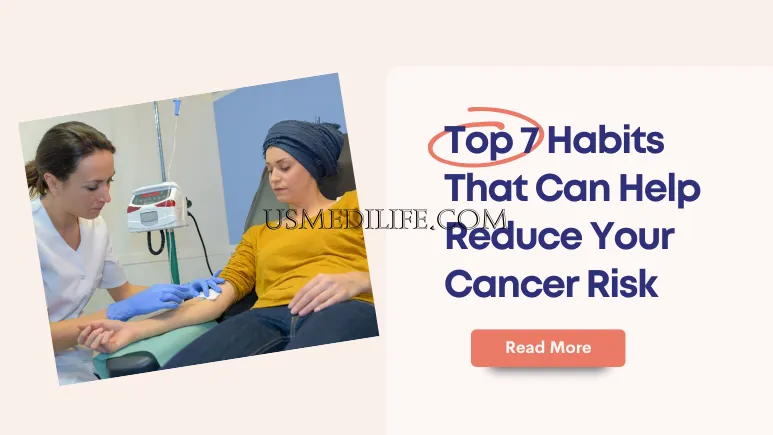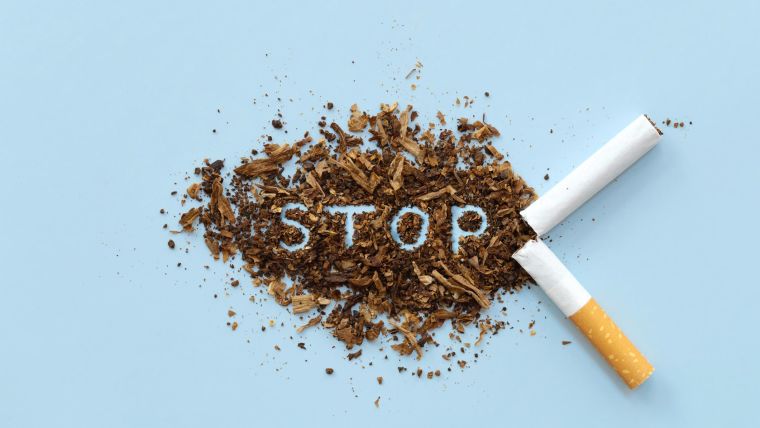
Dr. Ashwini
12-05-2025
Top 7 Habits That Can Help Reduce Your Cancer Risk
Cancer arises from a complex mix of genetics, environmental exposures, and lifestyle choices. While it's impossible to prevent it entirely, you can greatly reduce your chances by making informed changes to your everyday habits. Based on insights from leading health organizations like the American Cancer Society and WHO, here are seven practical steps you can take to support long-term health and reduce cancer risk.
1. Say No to Tobacco
Using tobacco is the number one avoidable cause of cancer. It’s strongly associated with cancers of the lungs, mouth, throat, pancreas, bladder, and more. Even passive exposure to smoke can be harmful.
How to Start: If you smoke or use tobacco, take steps to quit. Resources like the CDC’s Quitline (1-800-QUIT-NOW), nicotine patches, and counseling can help. Avoiding secondhand smoke is equally important opt for smoke-free spaces whenever possible.
Why It Matters: After quitting, your risk of lung cancer can be cut in half over the next decade.

2. Choose Whole Foods Over Processed Ones
What you eat plays a major role in your long-term health. Diets full of fiber-rich fruits, vegetables, and whole grains can protect against cancers such as colorectal, breast, and prostate.
How to Start: Build meals around fresh produce, swap white bread for whole grain options, and include healthy proteins like legumes or fish. Limit your intake of red meat and steer clear of processed meats like deli cuts and bacon.
Why It Matters: High-fiber diets can lower your risk of colorectal cancer by up to 20%.
3. Stay Active to Stay Protected
Regular movement helps manage hormones, maintain a healthy weight, and enhance immune defenses—all factors that help prevent cancer.
How to Start: Aim for 150 minutes of moderate activity weekly (such as brisk walking) or 75 minutes of intense activity (like jogging), plus strength training exercises twice per week. Even simple habits like walking instead of driving or taking the stairs can add up.
Why It Matters: Active individuals face a significantly lower risk of cancers like breast and colon compared to those who are sedentary.
4. Guard Your Skin Against UV Rays
Excessive sun exposure and tanning beds increase the risk of skin cancer, including the serious form known as melanoma.
How to Start: Apply broad-spectrum sunscreen with SPF 30 or higher every day, regardless of the weather. Wear sun-protective clothing, seek shade during peak hours (10 a.m. to 4 p.m.), and skip tanning beds entirely.
Why It Matters: Using sunscreen regularly can cut melanoma risk by half.
5. Drink Less Alcohol Or None at All
Alcohol consumption raises the risk of several cancers, including those of the breast, liver, and colon. Even moderate drinking can contribute to elevated risk.
How to Start: Limit intake to one drink per day for women and two for men or better yet, explore alcohol-free alternatives. Reducing the frequency of drinking is also beneficial.
Why It Matters: Limiting or eliminating alcohol can lower breast cancer risk by around 10%.
6. Keep Up with Screenings and Vaccinations
Early detection and prevention are critical tools in fighting cancer. Screenings catch early-stage cancers when treatment is more effective, and vaccines can prevent virus-linked cancers.
How to Start: Follow your healthcare provider’s recommendations for screenings like mammograms, Pap tests, colonoscopies, and lung scans. Get vaccinated against HPV (recommended up to age 45) and hepatitis B if you're at risk.
Why It Matters: Widespread HPV vaccination has already led to a 50% drop in cervical cancer rates in some populations.

7. Aim for a Healthy Body Weight
Being overweight or obese is linked to increased risk for 13 types of cancer, including those of the breast, pancreas, and kidneys.
How to Start: Focus on gradual, sustainable changes through nutritious eating and regular exercise. Track your body mass index (BMI) and aim for a healthy range between 18.5 and 24.9.
Why It Matters: Even modest weight loss (5–10%) can significantly reduce your cancer risk.
Other Helpful Practices
-
Manage Stress: Chronic stress may affect immune function. Try relaxation techniques like deep breathing, yoga, or journaling.
-
Limit Environmental Toxins: Reduce exposure to known carcinogens like asbestos, radon, and certain chemicals by testing your home and following safety protocols at work.
-
Understand Your Genetics: If you have a family history of cancer, genetic counseling or early screenings may be advisable.
FAQs
1. What is cancer?
Cancer is a group of diseases characterized by the uncontrolled growth and spread of abnormal cells in the body. These cells can form tumors or invade tissues and organs, disrupting normal function. Cancer can occur in almost any part of the body and is caused by genetic mutations, which may be triggered by lifestyle, environmental factors, or inherited traits.
2. What causes cancer?
Cancer is caused by a combination of factors, including:
-
Genetic mutations: Changes in DNA that disrupt normal cell growth.
-
Lifestyle factors: Tobacco use, poor diet, physical inactivity, and alcohol consumption.
-
Environmental exposures: UV radiation, pollution, asbestos, or radon.
-
Infections: Viruses like HPV (linked to cervical cancer) or hepatitis B (linked to liver cancer).
-
Inherited genes: Mutations like BRCA1/BRCA2 increase risk for breast and ovarian cancers.
Not all causes are fully understood, and sometimes cancer develops without a clear reason.
3. What are the most common types of cancer?
Globally, the most common cancers (based on 2020 WHO data) include:
-
Breast cancer
-
Lung cancer
-
Colorectal cancer
-
Prostate cancer
-
Skin cancer (non-melanoma and melanoma)
The prevalence varies by region, gender, and lifestyle factors.
4. What are the symptoms of cancer?
Symptoms depend on the cancer type and stage but may include:
-
Unexplained weight loss
-
Persistent fatigue
-
Lumps or swelling
-
Chronic pain
-
Changes in bowel or bladder habits
-
Unusual bleeding or discharge
-
Skin changes (e.g., new moles or sores that don’t heal)
Many symptoms are non-specific, so consult a doctor for proper diagnosis.
5. How is cancer diagnosed?
Cancer is diagnosed through:
-
Physical exams: Checking for lumps or abnormalities.
-
Imaging tests: X-rays, CT scans, MRIs, or ultrasounds to detect tumors.
-
Biopsies: Removing a tissue sample for microscopic analysis.
-
Blood tests: Detecting tumor markers (e.g., PSA for prostate cancer).
-
Screenings: Mammograms, colonoscopies, or Pap smears to catch cancer early.
Early detection often improves outcomes, so follow recommended screening guidelines.
6. Can cancer be prevented?
Not all cancers are preventable, but you can lower your risk by:
-
Avoiding tobacco and secondhand smoke.
-
Eating a balanced diet rich in fruits, vegetables, and whole grains.
-
Staying physically active (150 minutes of moderate exercise weekly).
-
Protecting skin from UV radiation with sunscreen and clothing.
-
Limiting alcohol to one drink/day for women, two for men.
-
Getting vaccinated against HPV and hepatitis B.
-
Undergoing regular screenings for early detection.
These habits can reduce risk by up to 30-50% for some cancers, per the American Cancer Society.
7. What are the main treatments for cancer?
Common treatments include:
-
Surgery: Removing tumors or affected tissues.
-
Radiation therapy: Using high-energy rays to kill cancer cells.
-
Chemotherapy: Drugs to destroy cancer cells or slow growth.
-
Immunotherapy: Boosting the immune system to fight cancer.
-
Targeted therapy: Drugs targeting specific cancer cell features.
-
Hormone therapy: Blocking hormones that fuel certain cancers (e.g., breast, prostate).
Treatment plans depend on cancer type, stage, and patient health.
8. What does "cancer stage" mean?
Cancer staging describes the size of the cancer and how far it has spread:
-
Stage 0: Early, non-invasive cancer (e.g., carcinoma in situ).
-
Stage I-III: Cancer is larger or has spread to nearby tissues/lymph nodes.
-
Stage IV: Cancer has spread to distant organs (metastatic).
Staging helps doctors plan treatment and predict outcomes.
9. Is cancer hereditary?
Some cancers have a hereditary component. Inherited mutations (e.g., BRCA1/BRCA2, Lynch syndrome) increase the risk of breast, ovarian, colorectal, and other cancers. However, only 5-10% of cancers are directly linked to inherited genes. Most cancers result from acquired mutations due to lifestyle or environmental factors. If you have a family history, discuss genetic testing with your doctor.
10. Can diet or supplements cure cancer?
No diet or supplement can cure cancer. However, a healthy diet can support treatment, improve energy, and reduce risk. Avoid unproven “miracle cures” or fad diets, as they may interfere with medical treatments. Always consult your oncologist before starting supplements, as some (e.g., high-dose antioxidants) may reduce chemotherapy effectiveness.
11. What is the survival rate for cancer?
Survival rates vary widely by cancer type, stage, and individual factors like age and health. For example:
-
Breast cancer: 5-year survival rate is ~90% for early-stage, ~30% for metastatic.
-
Lung cancer: ~60% for early-stage, ~6% for metastatic.
-
Prostate cancer: Nearly 100% for early-stage, ~30% for metastatic.
These figures, from the National Cancer Institute, are general and don’t predict individual outcomes. Advances in treatment are improving survival rates over time.
12. How can I support someone with cancer?
Supporting a loved one with cancer can include:
-
Listening without judgment and offering emotional support.
-
Helping with daily tasks like cooking, cleaning, or transportation to appointments.
-
Educating yourself about their diagnosis to understand their needs.
-
Respecting their privacy and treatment choices.
-
Encouraging them to join support groups or connect with organizations like the American Cancer Society.
Small gestures of care and presence can make a big difference.
13. Are there risks to cancer screenings?
Screenings like mammograms or colonoscopies are generally safe but may have risks, such as:
-
False positives, leading to unnecessary tests or anxiety.
-
Discomfort or minor complications (e.g., bleeding from a colonoscopy).
-
Radiation exposure from imaging (minimal in most cases).
The benefits of early detection usually outweigh risks, but discuss concerns with your doctor.
14. Why is cancer so common today?
Cancer appears more common due to:
-
Aging populations: Cancer risk increases with age.
-
Better detection: Improved screenings catch more cases early.
-
Lifestyle factors: Rising rates of obesity, smoking, and alcohol use in some populations.
-
Environmental exposures: Pollution and occupational hazards play a role.
However, cancer death rates are declining in many countries due to better treatments and prevention.
15. Where can I find reliable cancer information?
Trustworthy sources include:
-
National Cancer Institute (cancer.gov)
-
American Cancer Society (cancer.org)
-
World Health Organization (who.int)
-
CDC (cdc.gov/cancer)
-
Cancer Research UK (cancerresearchuk.org)
Beware of unverified claims on social media or websites promoting unproven treatments.
Final Thoughts
Although there's no guaranteed way to prevent cancer, taking control of your lifestyle can dramatically reduce your risk. Small changes quitting tobacco, eating more whole foods, staying active, and attending screenings can make a big difference over time. Talk to a healthcare provider about your personal risk factors and take proactive steps today for a healthier tomorrow.


